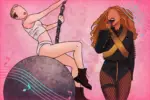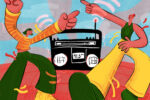Dance Dance Revolution
A new trend is revolutionizing the music industry as songs and dances keep old music alive.
By Shannon Mondesir, Brooklyn College
Music and dance have always been a source of enjoyment for people, young and old.
From swing and disco to the electric slide and the mashed potato, dances are constantly being created to keep people on their toes. Songs are released and need dances to go along with them. Why else would there be music videos? People need direction, a starting place to put their feet and where to move their hips, especially those who are not as physically inclined in the sport of dance.
This era is no different, for the early aughts welcomed many popular dances that millennials remember, such as “the Soulja Boy” in 2007, the line dance to the jazzy melody of “Step in the Name of Love” by R. Kelly, and the song every kid heard at parties, the famous Mr. C’s “Cha-Cha Slide.”
Nowadays, though, along with a cool dance to match a groovy, new song, millennials have old music that is being thrown into the new generation and posing as songs that have just released. “Throwback” songs, as they are called, have been getting more and more popular, as they are thrown out for the public to listen to and dances are created to go along with them.
Take the famous “Why You Always Lyin‘” meme as an example. With the same rhythmic beats to the original song Next’s “Too Close,” Instagram comedian @downgoes.fraser changed the lyrics to the song to fit a joke he was trying to make. Millions shared, reposted and tweeted his videos, which led to hordes of young people making their way to the original song on YouTube.
The comments on the 90s R&B music video ranged from the curious enjoyment of finding the song through a funny meme, to offhanded comments claiming that the funny version was better. Nevertheless, the meme garnered attention to a song that was formerly only known to real R&B lovers.
The “Running Man” Challenge is another crazed fad that became popular in early 2016, this one to the old jam “My Boo” by Ghost Town DJ. The “Running Man” dance itself was popular in the late 80s, but it died off until two University of Maryland students revived it, which erupted into a phenomenon of kids, teenagers, adults and news anchors all taking part in bringing recognition to a great song.
In the last six months alone, there have been countless musical challenges, including the “So Gone” remix challenge, where one must rap a part of the great Monica song.
Considering the trend, you have to ask why it is predominantly old songs that fit these dance memes best? While one used to have to listen to their parents embarrassingly sing at barbecues or blast their “ancient people music” in the house, these old gems are now being brought to the attention of young people everywhere and are being appreciated for the art that they are.
People have always argued about the new age of music and where it stands, especially those from older generations. “You don’t know what good music is,” a parent may tell you. “Trey Songz isn’t music, but Smokey Robinson! Now, he is music!”
The constant back and forth argument about whether Tupac and Biggie are irrelevant now that J Cole and Chance the Rapper are moving mountains is real for those who truly believe in the importance of music.
“We can’t forget the greats,” baby boomers say indignantly. “The pioneers of music are the influences of your favorite artists today!” “It’s a new sound,” young people may argue back. “They don’t sound the same! What’s in is in, what’s out is has been.” Can music really be out?
No. Music will always be. Search 1920s folk songs on YouTube and chances are you’ll find a whole playlist. Now, search 90s R&B, and see pages upon pages of the best R&B artists that have blessed the Earth with their voices and sensuality.
Music will never die and it can never be forgotten, because it will always be there, through websites, books and people. These musical challenges becoming more and more popular aid in keeping older music alive. It’s more than just a new download, for it exposes people to genres of music that they may have never listened to before or may have never discovered on their own.
So, where are these new dance crazes coming from? Is there an unknown, desolate land up in the mountains where people, gathered together hunched over notebooks and laptops, are planning ways to bring back the next hit song from a past decade? Perhaps it’s less dramatic than that, but either way, if it gets you into a dancing mood, then why question it?


















[…] Read the full article from the Source… […]
[…] Read the full article from the Source… […]
[…] Read the full article from the Source… […]
[…] Read the complete version from the Source… […]
[…] Read the full article from the Source… […]
[…] Read the full article from the Source… […]
[…] Read the full article from the Source… […]
[…] Resurrecting the Oldies: Modern-Day Musical Challenges […]